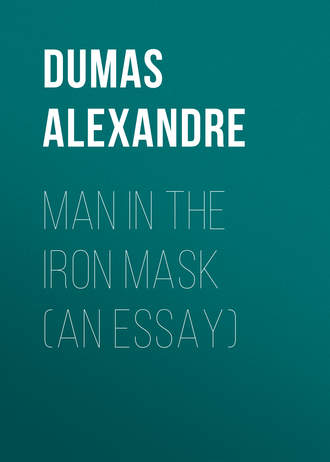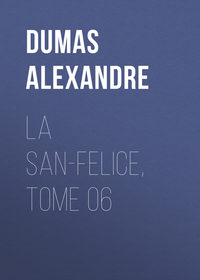 полная версия
полная версияMan in the Iron Mask (an Essay)
Although the first part was a great success, the promised sequel never appeared. It must be admitted that such a story, though it never convinced a single person of the illegitimacy of Louis XIV, was an excellent prologue to the tale of the unfortunate lot of the Man in the Iron Mask, and increased the interest and curiosity with which that singular historical mystery was regarded. But the views of the Dutch scholars thus set forth met with little credence, and were soon forgotten in a new solution.
The third historian to write about the prisoner of the Iles Sainte-Marguerite was Lagrange-Chancel. He was just twenty-nine years of age when, excited by Freron’s hatred of Voltaire, he addressed a letter from his country place, Antoniat, in Perigord, to the ‘Annee Litteraire’ (vol. iii. p. 188), demolishing the theory advanced in the ‘Siecle de Louis XIV’, and giving facts which he had collected whilst himself imprisoned in the same place as the unknown prisoner twenty years later.
“My detention in the Iles-Saint-Marguerite,” says Lagrange-Chancel,” brought many things to my knowledge which a more painstaking historian than M. de Voltaire would have taken the trouble to find out; for at the time when I was taken to the islands the imprisonment of the Man in the Iron Mask was no longer regarded as a state secret. This extraordinary event, which M. de Voltaire places in 1662, a few months after the death of Cardinal Mazarin, did not take place till 1669, eight years after the death of His Eminence. M. de La Motte-Guerin, commandant of the islands in my time, assured me that the prisoner was the Duc de Beaufort, who was reported killed at the siege of Candia, but whose body had never been recovered, as all the narratives of that event agree in stating. He also told me that M. de Saint-Mars, who succeeded Pignerol as governor of the islands, showed great consideration for the prisoner, that he waited on him at table, that the service was of silver, and that the clothes supplied to the prisoner were as costly as he desired; that when he was ill and in need of a physician or surgeon, he was obliged under pain of death to wear his mask in their presence, but that when he was alone he was permitted to pull out the hairs of his beard with steel tweezers, which were kept bright and polished. I saw a pair of these which had been actually used for this purpose in the possession of M. de Formanoir, nephew of Saint-Mars, and lieutenant of a Free Company raised for the purpose of guarding the prisoners. Several persons told me that when Saint-Mars, who had been placed over the Bastille, conducted his charge thither, the latter was heard to say behind his iron mask, ‘Has the king designs on my life?’ To which Saint-Mars replied, ‘No, my prince; your life is safe: you must only let yourself be guided.’
“I also learned from a man called Dubuisson, cashier to the well-known Samuel Bernard, who, having been imprisoned for some years in the Bastile, was removed to the Iles Sainte-Marguerite, where he was confined along with some others in a room exactly over the one occupied by the unknown prisoner. He told me that they were able to communicate with him by means of the flue of the chimney, but on asking him why he persisted in not revealing his name and the cause of his imprisonment, he replied that such an avowal would be fatal not only to him but to those to whom he made it.
“Whether it were so or not, to-day the name and rank of this political victim are secrets the preservation of which is no longer necessary to the State; and I have thought that to tell the public what I know would cut short the long chain of circumstances which everyone was forging according to his fancy, instigated thereto by an author whose gift of relating the most impossible events in such a manner as to make them seem true has won for all his writings such success – even for his Vie de Charles XII”
This theory, according to Jacob, is more probable than any of the others.
“Beginning with the year 1664.,” he says, “the Duc de Beaufort had by his insubordination and levity endangered the success of several maritime expeditions. In October 1666 Louis XIV remonstrated with him with much tact, begging him to try to make himself more and more capable in the service of his king by cultivating the talents with which he was endowed, and ridding himself of the faults which spoilt his conduct. ‘I do not doubt,’ he concludes, ‘that you will be all the more grateful to me for this mark of my benevolence towards you, when you reflect how few kings have ever shown their goodwill in a similar manner.’” ( ‘Oeuvres de Louis XIV’, vol. v. p. 388). Several calamities in the royal navy are known to have been brought about by the Duc de Beaufort. M. Eugene Sue, in his ‘Histoire de la Marine’, which is full of new and curious information, has drawn a very good picture of the position of the “roi des halles,” the “king of the markets,” in regard to Colbert and Louis XIV. Colbert wished to direct all the manoeuvres of the fleet from his study, while it was commanded by the naval grandmaster in the capricious manner which might be expected from his factious character and love of bluster (Eugene Sue, vol. i., ‘Pieces Justificatives’). In 1699 Louis XIV sent the Duc de Beaufort to the relief of Candia, which the Turks were besieging. Seven hours after his arrival Beaufort was killed in a sortie. The Duc de Navailles, who shared with him the command of the French squadron, simply reported his death as follows: “He met a body of Turks who were pressing our troops hard: placing himself at the head of the latter, he fought valiantly, but at length his soldiers abandoned him, and we have not been able to learn his fate” [‘Memoires du Duc de Navailles’, book iv. P. 243)
The report of his death spread rapidly through France and Italy; magnificent funeral services were held in Paris, Rome, and Venice, and funeral orations delivered. Nevertheless, many believed that he would one day reappear, as his body had never been recovered.
Guy Patin mentions this belief, which he did not share, in two of his letters: —
“Several wagers have been laid that M. de Beaufort is not dead! ‘O utinam’!” (Guy Patin, September 26, 1669).
“It is said that M. de Vivonne has been granted by commission the post of vice-admiral of France for twenty years; but there are many who believe that the Duc de Beaufort is not dead, but imprisoned in some Turkish island. Believe this who may, I don’t; he is really dead, and the last thing I should desire would be to be as dead as he”,(Ibid., January 14, 1670).
The following are the objections to this theory:
“In several narratives written by eye-witnesses of the siege of Candia,” says Jacob, “it is related that the Turks, according to their custom, despoiled the body and cut off the head of the Duc de Beaufort on the field of battle, and that the latter was afterwards exhibited at Constantinople; and this may account for some of the details given by Sandras de Courtilz in his ‘Memoires du Marquis de Montbrun’ and his ‘Memoires d’Artagnan’, for one can easily imagine that the naked, headless body might escape recognition. M. Eugene Sue, in his ‘Histoire de la Marine’ (vol. ii, chap. 6), had adopted this view, which coincides with the accounts left by Philibert de Jarry and the Marquis de Ville, the MSS. of whose letters and ‘Memoires’ are to be found in the Bibliotheque du Roi.
“In the first volume of the ‘Histoire de la Detention des Philosophes et des Gens de Lettres a la Bastille, etc.’, we find the following passage: —
“Without dwelling on the difficulty and danger of an abduction, which an Ottoman scimitar might any day during this memorable siege render unnecessary, we shall restrict ourselves to declaring positively that the correspondence of Saint-Mars from 1669 to 1680 gives us no ground for supposing that the governor of Pignerol had any great prisoner of state in his charge during that period of time, except Fouquet and Lauzun.’”
While we profess no blind faith in the conclusions arrived at by the learned critic, we would yet add to the considerations on which he relies another, viz. that it is most improbable that Louis XIV should ever have considered it necessary to take such rigorous measures against the Duc de Beaufort. Truculent and self-confident as he was, he never acted against the royal authority in such a manner as to oblige the king to strike him down in secret; and it is difficult to believe that Louis XIV, peaceably seated on his throne, with all the enemies of his minority under his feet, should have revenged himself on the duke as an old Frondeur.
The critic calls our attention to another fact also adverse to the theory under consideration. The Man in the Iron Mask loved fine linen and rich lace, he was reserved in character and possessed of extreme refinement, and none of this suits the portraits of the ‘roi des halles’ which contemporary historians have drawn.
Regarding the anagram of the name Marchiali (the name under which the death of the prisoner was registered), ‘hic amiral’, as a proof, we cannot think that the gaolers of Pignerol amused themselves in propounding conundrums to exercise the keen intellect of their contemporaries; and moreover the same anagram would apply equally well to the Count of Vermandois, who was made admiral when only twenty-two months old. Abbe Papon, in his roamings through Provence, paid a visit to the prison in which the Iron Mask was confined, and thus speaks: —
“It was to the Iles Sainte-Marguerite that the famous prisoner with the iron mask whose name has never been discovered, was transported at the end of the last century; very few of those attached to his service were allowed to speak to him. One day, as M. de Saint-Mars was conversing with him, standing outside his door, in a kind of corridor, so as to be able to see from a distance everyone who approached, the son of one of the governor’s friends, hearing the voices, came up; Saint-Mars quickly closed the door of the room, and, rushing to meet the young man, asked him with an air of great anxiety if he had overheard anything that was said. Having convinced himself that he had heard nothing, the governor sent the young man away the same day, and wrote to the father that the adventure was like to have cost the son dear, and that he had sent him back to his home to prevent any further imprudence.
“I was curious enough to visit the room in which the unfortunate man was imprisoned, on the 2nd of February 1778. It is lighted by one window to the north, overlooking the sea, about fifteen feet above the terrace where the sentries paced to and fro. This window was pierced through a very thick wall and the embrasure barricaded by three iron bars, thus separating the prisoner from the sentries by a distance of over two fathoms. I found an officer of the Free Company in the fortress who was nigh on fourscore years old; he told me that his father, who had belonged to the same Company, had often related to him how a friar had seen something white floating on the water under the prisoner’s window. On being fished out and carried to M. de Saint-Mars, it proved to be a shirt of very fine material, loosely folded together, and covered with writing from end to end. M. de Saint-Mars spread it out and read a few words, then turning to the friar who had brought it he asked him in an embarrassed manner if he had been led by curiosity to read any of the, writing. The friar protested repeatedly that he had not read a line, but nevertheless he was found dead in bed two days later. This incident was told so often to my informant by his father and by the chaplain of the fort of that time that he regarded it as incontestably true. The following fact also appears to me to be equally well established by the testimony of many witnesses. I collected all the evidence I could on the spot, and also in the Lerins monastery, where the tradition is preserved.
“A female attendant being wanted for the prisoner, a woman of the village of Mongin offered herself for the place, being under the impression that she would thus be able to make her children’s fortune; but on being told that she would not only never be allowed to see her children again, but would be cut off from the rest of the world as well, she refused to be shut up with a prisoner whom it cost so much to serve. I may mention here that at the two outer angles of the wall of the fort which faced the sea two sentries were placed, with orders to fire on any boat which approached within a certain distance.
“The prisoner’s personal attendant died in the Iles Sainte-Marguerite. The brother of the officer whom I mentioned above was partly in the confidence of M. de Saint-Mars, and he often told how he was summoned to the prison once at midnight and ordered to remove a corpse, and that he carried it on his shoulders to the burial-place, feeling certain it was the prisoner who was dead; but it was only his servant, and it was then that an effort was made to supply his place by a female attendant.”
Abbe Papon gives some curious details, hitherto unknown to the public, but as he mentions no names his narrative cannot be considered as evidence. Voltaire never replied to Lagrange-Chancel, who died the same year in which his letter was published. Freron desiring to revenge himself for the scathing portrait which Voltaire had drawn of him in the ‘Ecossaise’, called to his assistance a more redoubtable adversary than Lagrange-Chancel. Sainte-Foix had brought to the front a brand new theory, founded on a passage by Hume in an article in the ‘Annee Litteraire (1768, vol. iv.), in which he maintained that the Man in the Iron Mask was the Duke of Monmouth, a natural son of Charles II, who was found guilty of high treason and beheaded in London on the 15th July 1685.
This is what the English historian says:
“It was commonly reported in London that the Duke of Monmouth’s life had been saved, one of his adherents who bore a striking resemblance to the duke having consented to die in his stead, while the real culprit was secretly carried off to France, there to undergo a lifelong imprisonment.”
The great affection which the English felt for the Duke of Monmouth, and his own conviction that the people only needed a leader to induce them to shake off the yoke of James II, led him to undertake an enterprise which might possibly have succeeded had it been carried out with prudence. He landed at Lyme, in Dorset, with only one hundred and twenty men; six thousand soon gathered round his standard; a few towns declared in his favour; he caused himself to be proclaimed king, affirming that he was born in wedlock, and that he possessed the proofs of the secret marriage of Charles II and Lucy Waiters, his mother. He met the Royalists on the battlefield, and victory seemed to be on his side, when just at the decisive moment his ammunition ran short. Lord Gray, who commanded the cavalry, beat a cowardly retreat, the unfortunate Monmouth was taken prisoner, brought to London, and beheaded.
The details published in the ‘Siecle de Louis XIV’ as to the personal appearance of the masked prisoner might have been taken as a description of Monmouth, who possessed great physical beauty. Sainte-Foix had collected every scrap of evidence in favour of his solution of the mystery, making use even of the following passage from an anonymous romance called ‘The Loves of Charles II and James II, Kings of England’: —
“The night of the pretended execution of the Duke of Monmouth, the king, attended by three men, came to the Tower and summoned the duke to his presence. A kind of loose cowl was thrown over his head, and he was put into a carriage, into which the king and his attendants also got, and was driven away.”
Sainte-Foix also referred to the alleged visit of Saunders, confessor to James II, paid to the Duchess of Portsmouth after the death of that monarch, when the duchess took occasion to say that she could never forgive King James for consenting to Monmouth’s execution, in spite of the oath he had taken on the sacred elements at the deathbed of Charles II that he would never take his natural brother’s life, even in case of rebellion. To this the priest replied quickly, “The king kept his oath.”
Hume also records this solemn oath, but we cannot say that all the historians agree on this point. ‘The Universal History’ by Guthrie and Gray, and the ‘Histoire d’Angleterre’ by Rapin, Thoyras and de Barrow, do not mention it.
“Further,” wrote Sainte-Foix, “an English surgeon called Nelaton, who frequented the Cafe Procope, much affected by men of letters, often related that during the time he was senior apprentice to a surgeon who lived near the Porte Saint-Antoine, he was once taken to the Bastille to bleed a prisoner. He was conducted to this prisoner’s room by the governor himself, and found the patient suffering from violent headache. He spoke with an English accent, wore a gold-flowered dressing-gown of black and orange, and had his face covered by a napkin knotted behind his head.”
This story does not hold water: it would be difficult to form a mask out of a napkin; the Bastille had a resident surgeon of its own as well as a physician and apothecary; no one could gain access to a prisoner without a written order from a minister, even the Viaticum could only be introduced by the express permission of the lieutenant of police.
This theory met at first with no objections, and seemed to be going to oust all the others, thanks, perhaps, to the combative and restive character of its promulgator, who bore criticism badly, and whom no one cared to incense, his sword being even more redoubtable than his pen.
It was known that when Saint-Mars journeyed with his prisoner to the Bastille, they had put up on the way at Palteau, in Champagne, a property belonging to the governor. Freron therefore addressed himself to a grand-nephew of Saint-Mars, who had inherited this estate, asking if he could give him any information about this visit. The following reply appeared in the ‘Annee Litteraire (June 1768): —
“As it appears from the letter of M. de Sainte-Foix from which you quote that the Man in the Iron Mask still exercises the fancy of your journalists, I am willing to tell you all I know about the prisoner. He was known in the islands of Sainte-Marguerite and at the Bastille as ‘La Tour.’ The governor and all the other officials showed him great respect, and supplied him with everything he asked for that could be granted to a prisoner. He often took exercise in the yard of the prison, but never without his mask on. It was not till the ‘Siecle’ of M. de Voltaire appeared that I learned that the mask was of iron and furnished with springs; it may be that the circumstance was overlooked, but he never wore it except when taking the air, or when he had to appear before a stranger.
“M. de Blainvilliers, an infantry officer who was acquainted with M. de Saint-Mars both at Pignerol and Sainte-Marguerite, has often told me that the lot of ‘La Tour’ greatly excited his curiosity, and that he had once borrowed the clothes and arms of a soldier whose turn it was to be sentry on the terrace under the prisoner’s window at Sainte-Marguerite, and undertaken the duty himself; that he had seen the prisoner distinctly, without his mask; that his face was white, that he was tall and well proportioned, except that his ankles were too thick, and that his hair was white, although he appeared to be still in the prime of life. He passed the whole of the night in question pacing to and fro in his room. Blainvilliers added that he was always dressed in brown, that he had plenty of fine linen and books, that the governor and the other officers always stood uncovered in his presence till he gave them leave to cover and sit down, and that they often bore him company at table.
“In 1698 M. de Saint-Mars was promoted from the governorship of the Iles Sainte-Marguerite to that of the Bastille. In moving thither, accompanied by his prisoner, he made his estate of Palteau a halting-place. The masked man arrived in a litter which preceded that of M. de Saint-Mars, and several mounted men rode beside it. The peasants were assembled to greet their liege lord. M. de Saint-Mars dined with his prisoner, who sat with his back to the dining-room windows, which looked out on the court. None of the peasants whom I have questioned were able to see whether the man kept his mask on while eating, but they all noticed that M. de Saint-Mars, who sat opposite to his charge, laid two pistols beside his plate; that only one footman waited at table, who went into the antechamber to change the plates and dishes, always carefully closing the dining-room door behind him. When the prisoner crossed the courtyard his face was covered with a black mask, but the peasants could see his lips and teeth, and remarked that he was tall, and had white hair. M. de Saint-Mars slept in a bed placed beside the prisoner’s. M. de Blainvilliers told me also that ‘as soon as he was dead, which happened in 1704, he was buried at Saint-Paul’s,’ and that ‘the coffin was filled with substances which would rapidly consume the body.’ He added, ‘I never heard that the masked man spoke with an English accent.’”
Sainte-Foix proved the story related by M. de Blainvilliers to be little worthy of belief, showing by a circumstance mentioned in the letter that the imprisoned man could not be the Duc de Beaufort; witness the epigram of Madame de Choisy, “M. de Beaufort longs to bite and can’t,” whereas the peasants had seen the prisoner’s teeth through his mask. It appeared as if the theory of Sainte-Foix were going to stand, when a Jesuit father, named Griffet, who was confessor at the Bastille, devoted chapter xiii, of his ‘Traite des differentes Sortes de Preuves qui servent a etablir la Verite dans l’Histoire’ (12mo, Liege, 1769) to the consideration of the Iron Mask. He was the first to quote an authentic document which certifies that the Man in the Iron Mask about whom there was so much disputing really existed. This was the written journal of M. du Jonca, King’s Lieutenant in the Bastille in 1698, from which Pere Griffet took the following passage: —
“On Thursday, September the 8th, 1698, at three o’clock in the afternoon, M. de Saint-Mars, the new governor of the Bastille, entered upon his duties. He arrived from the islands of Sainte-Marguerite, bringing with him in a litter a prisoner whose name is a secret, and whom he had had under his charge there, and at Pignerol. This prisoner, who was always masked, was at first placed in the Bassiniere tower, where he remained until the evening. At nine o’clock p.m. I took him to the third room of the Bertaudiere tower, which I had had already furnished before his arrival with all needful articles, having received orders to do so from M. de Saint-Mars. While I was showing him the way to his room, I was accompanied by M. Rosarges, who had also arrived along with M. de Saint-Mars, and whose office it was to wait on the said prisoner, whose table is to be supplied by the governor.”
Du Jonca’s diary records the death of the prisoner in the following terms: —
“Monday, 19th November 1703. The unknown prisoner, who always wore a black velvet mask, and whom M. de Saint-Mars brought with him from the Iles Sainte-Marguerite, and whom he had so long in charge, felt slightly unwell yesterday on coming back from mass. He died to-day at 10 p.m. without having a serious illness, indeed it could not have been slighter. M. Guiraut, our chaplain, confessed him yesterday, but as his death was quite unexpected he did not receive the last sacraments, although the chaplain was able to exhort him up to the moment of his death. He was buried on Tuesday the 20th November at 4 P.M. in the burial-ground of St. Paul’s, our parish church. The funeral expenses amounted to 40 livres.”
His name and age were withheld from the priests of the parish. The entry made in the parish register, which Pere Griffet also gives, is in the following words: —
“On the 19th November 1703, Marchiali, aged about forty-five, died in the Bastille, whose body was buried in the graveyard of Saint-Paul’s, his parish, on the 20th instant, in the presence of M. Rosarges and of M. Reilh, Surgeon-Major of the Bastille.
“(Signed) ROSARGES.
“REILH.”
As soon as he was dead everything belonging to him, without exception, was burned; such as his linen, clothes, bed and bedding, rugs, chairs, and even the doors of the room he occupied. His service of plate was melted down, the walls of his room were scoured and whitewashed, the very floor was renewed, from fear of his having hidden a note under it, or left some mark by which he could be recognised.









